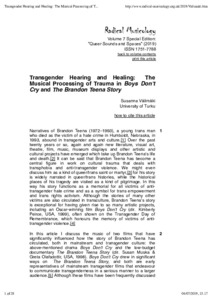Transgender Hearing and Healing: The Musical Processing of Trauma in Boys Don’t Cry and The Brandon Teena Story
Susanna Välimäki
https://urn.fi/URN:NBN:fi-fe2021042823467
Tiivistelmä
In this
article I discuss the music of two films that have significantly influenced how
the story of a famous victim of an anti-transgender hate crime, Brandon Teena,
has circulated, both in mainstream and transgender culture: the Oscar-winning
drama film Boys Don’t Cry (dir.
Kimberly Peirce, USA, 1999), and the low-budget documentary The Brandon Teena Story (dir. Susan
Muska & Greta Olafsdottir, USA, 1998). Boys
Don’t Cry drew in significant ways on The Brandon Teena Story, and both are
early representatives of mainstream transgender films that endeavour to
communicate transgenderness in a serious manner to a larger audience.
Although
these films have been frequently discussed in queer and transgender studies, the
role of the music in the films has been relatively untouched. Yet film itself
is a sonic art form, and audiovisual effects involving music are among the most
powerful technologies for portraying gender. Furthermore, music is an especially
capable vehicle for processing collective traumas, such as soci(et)al
oppression and hate-motivated violence. In the
present article I am interested in the musical means by which Boys Don’t Cry and The Brandon Teena Story
convey the story of Brandon Teena and handle anti-transgender violence. More
specifically, by drawing on transgender musicology, cultural film music research and cultural trauma studies, I will
focus on how the films communicate transgender subjectivity and narrate the
traumatic subject matter via music. I will also discuss the affinities and
differences in the musical approaches of these films.
Kokoelmat
- Rinnakkaistallenteet [19207]
